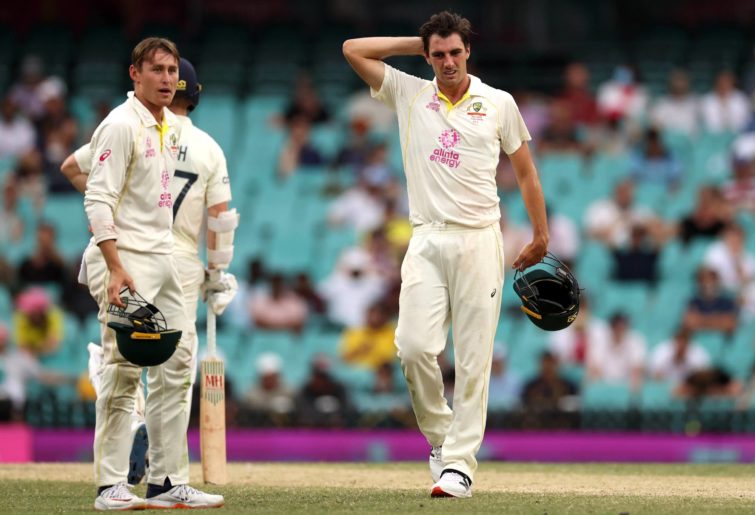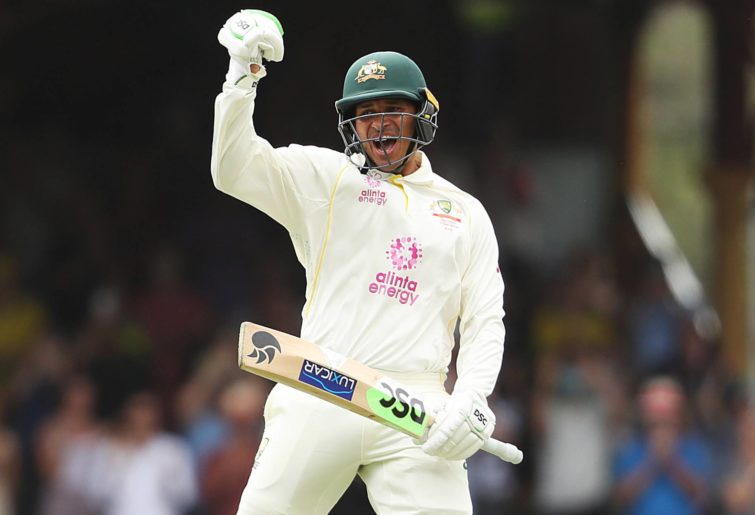Australian captain Pat Cummins has defended his declaration call to end the team’s second innings on day four of the SCG Test, amid criticism that he was overly cautious in allowing the innings to continue.
The delayed move allowed England to hold on for a thrilling draw with just one wicket to spare on day five, and avoid a dreaded series whitewash. However, Cummins maintained the pitch was still true enough that even a target of 350 would have been ‘pretty achievable’ had he declared then.
Cummins also called for changes to be made to some of Test cricket’s archaic traditions, with criticism levelled at taking scheduled breaks in pockets of sunshine across days one and two while rain washed out most of the scheduled day’s play.
As for Usman Khawaja’s chances of keeping his spot following spectacular twin centuries, the captain was non-committal, but admits the selectors will find it tough to omit the popular left-hander.
Here is everything Pat Cummins said after the fourth Ashes Test at the SCG.
On his declaration
Cummins waited until the final hour of play on day four to call a halt to the Australian second innings, to set England a target of 388.
While defeat was never truly on the cards, openers Zak Crawley and Haseeb Hameed saw out the 11 overs remaining for the day, before England fought out a gutsy draw that went to the final ball of day five, as number eleven Jimmy Anderson blocked out the final over from Steve Smith.
Despite the criticism, Cummins has defended the extended innings, saying the pitch was true enough to make setting England a total tricky.
“I wanted [to set] around about 3 and a half [runs] an over… I thought 110 overs was enough time,” Cummins said of the timing of his declaration.
“I thought the wicket was still not playing too many tricks. I thought if they batted really well, 350’s pretty achievable out there.
“I wanted to give us enough time… having the luxury after the way Greeny and Usman batted to have enough runs in the bank [meant] that we could attack for those whole 110 overs.”
Cummins denied suggestions that the team was too defensively-minded, saying the team were ‘for sure… willing to risk England winning’ to push for a victory of their own.
“I think the game was ticking along at around about that rate [three and a half runs per over], maybe about three runs per over. I thought 110 or so overs at that rate still gave them a little bit of a cherry if a couple of batters got in,” he said.
“The day 5 wicket [in Sydney] doesn’t play like a traditional broken-up day five wicket.
“We were hoping for 110-plus overs, we thought that’d be enough; but in the back of our minds we knew it may potentially be a bit of a grind out there.
“I think the pitch played quite differently to the first three Test matches. There wasn’t a lot of sideways movement, lot of swing, or even a lot of swing for ‘Lyono’ [Nathan Lyon]. But I thought they [England] played well.”
Cummins said a factor in his delayed call was to ensure his team could consistently attack with the ball, with little thought ever going towards stopping runs on the final day.
“Having a lot of runs on the board meant we could get pretty creative,” he said.
“It always felt like we were looking for wickets as opposed to trying to save a match or anything like that. It was a lot of fun.”
It’s the second Sydney Test in a row where Australia have failed to bowl out their opponents, having fallen four wickets short of victory over India in the corresponding Test 12 months ago. However, Cummins believes the performance of his bowling attack this time around was far better.
“From this year compared to last year, I think we made some improvements,” he said. “We stuck at some plans a little bit longer.
“When you’re that far ahead of the game, of course you want to win it. I thought England played well, I was really proud with how everyone went.
“We stuck at it; I thought we bowled quite well. We got close, just not close enough.”

at Cummins of Australia looks on as bad light sets in during day five of the Fourth Test Match in the Ashes series between Australia and England at Sydney Cricket Ground on January 09, 2022 in Sydney, Australia. (Photo by Cameron Spencer/Getty Images)
On changing cricket’s traditions in rainy conditions
Derided even more than Cummins’ declaration call was Sydney’s famously fickle weather, the city’s Test once again besieged by rain.
No venue in the country has seen more days washed out in the past 50 years than the SCG, with only 46.5 overs bowled on day one and only 65 on day three. The shortened days would prove crucial as England escaped defeat by the skin of their teeth.
Criticism has in particular been directed at cricket’s rigid intervals, which most egregiously saw the two teams take the standard 40-minute lunch break on day one after some early showers, only for the sun to briefly come out during the break and disappear shortly thereafter.
Cummins agreed with suggestions the ‘traditions of Test cricket’ needed tweaking to allow as much play as possible, while also questioning whether the now-traditional day one opening ceremony, which includes the national anthems and the Welcome to Country, could also be scrapped.
“I think on day one we gave a bit of an allowance for the anthems, the opening ceremony, when there was sunlight there for a little while,” the captain said.
“I don’t know the answers, but I think if it’s not raining and we’ve been sitting down all morning, let’s try and play as much cricket as we can.”
“[On days one and three] you feel like you were sitting down for half a day because it’s raining, and then [when] it’s sunny for a big portion, you have big breaks.
“It’s been around forever, it’s one of those traditions. I’d be happy if we found some more overs somehow.”
On the thrilling finish
Cummins’ captaincy was put to its first real test in the final hour of the match, as England tailenders Jack Leach and Stuart Broad bunkered down.
With the Ashes already secure, the captain was able to enjoy the challenge, describing the tense late moments as ‘a lot of fun’ despite the end result.
“I feel like I was able to make quite a few calls – some came off and some didn’t – but it was good fun,” he said.
The drama was compounded when fading light saw the umpires bar Cummins from bowling any of his fast bowlers, including himself, for the final three overs of the day, forcing him to turn to Steve Smith’s part-time leg-breaks in addition to lead spinner Nathan Lyon to try and take the last two wickets.
The forced move nearly worked, with Smith removing Leach; but Cummins admitted after play his preference was to give Scott Boland a chance to make his remarkable start to Test life even more extraordinary.
“I would have liked to bowl Scott, but I think it was probably the right decision, to be fair,” Cummins said of the umpires’ spin-only call.
“It was pretty dark out there… [I was] disappointed we couldn’t use Scotty, even Greeny [Cameron Green] – I think I told Greeny to warm up about five times.
“It is what it is, it was pretty dark, I think they made the right call.”
Australia’s desperation for the final wickets led to some extraordinary fields; in the closing stages, every fielder crowded around the bat, with the captain himself donning a helmet and placing himself in close.
“I don’t think I’ve ever been under a ‘lid’, fielding,” Cummins laughed.
“I was trying to remember whether I did it in junior cricket. It was fun.
“It’s hard with the grille, you can’t see the ball, I don’t know how they do it!”
Cummins said the challenge of trying to remove England’s stubborn tail at the death was enjoyable, despite Australia’s eventual failure to finish the job.
“The last hour or two, you’re normally setting a field to try and take wickets but to stop runs. It was purely just ‘where do you think a catch might go?’ I loved it,” he said.
He maintains the experience of the final day will benefit his captaincy in the long run.
“I certainly learned a lot. I felt even from the second innings compared to the first, I felt a lot calmer, in control,” Cummins said.
“I felt like we managed the pace of the game better than we might have perhaps at times in the first innings. There were a few things, waiting on Scotty Boland, a few other things that we had to manage at the same time, but I felt a lot more in control that second innings.
“That was a bit of a learning, just take that extra second and take that breath at the top of the mark, speak to the bowler, have really clear plans.”
On Usman Khawaja
Returning to the Test team for the first time in over two years after Travis Head’s positive COVID-19 Test, Usman Khawaja forced a major headache for Australia’s selectors, scoring twin centuries to be the obvious player of the match.
Selector Tony Dodemaide was tight-lipped when asked about Khawaja’s chances of retaining his spot in the side in an appearance on 7 Cricket; but while he isn’t part of the committee, Cummins has given the Queensland captain a ringing endorsement.

(Photo by Mark Metcalfe – CA/Cricket Australia via Getty Images)
“I’m not a selector, but someone comes out and hits two hundreds, it’s pretty hard to go past him for the week after,” Cummins said.
“We’ll work through that, the selectors will work through that over the next few days, but [when] someone’s running hot and got a heap of experience like Uzzy, the way he played was just fantastic.”
Aiding Khawaja’s chances is his flexibility, leaving him capable of batting in the middle order, as he did in Sydney, or shifting up the order to replace the vulnerable Marcus Harris as an opener.
“I guess that’s why he was the spare batter and picked in the squad originally. It felt like he could replace any batter one to six really well,” Cummins said.
“I think he’s hugely versatile.”
While Khawaja’s poor record overseas could hinder his chances of a long-term return to the Test team with tours of Pakistan, Sri Lanka and India to come in 2022, Cummins says those troubles are a thing of the past.
“I know there’s been question marks historically on him playing over in Asia, but you see how well he’s played spin recently: reverse-sweeping, sweeping,” the captain said.
“He’s just someone in total command of his game, and that’s why you love experience.
“Two centuries rarely happens in a career, so to come back in his first Test, fantastic.”
Cummins also hinted at further changes to his bowling attack for Hobart, revealing Boland is ‘a little bit sore’ despite seven further wickets in Sydney to continue his dream start to his Test career.
Should Boland, or a noticeably proppy Mitchell Starc, be deemed unfit for the series finale, Adelaide Oval hero Jhye Richardson looms as the most likely replacement. But Cummins says they will cross that bridge when they come to it, describing the fast bowling depth in the squad as ‘a good problem to have’.
“I think we’ve got six or seven days [until the Hobart Test], so we’ll take our time and we’ll see how all the bowlers pull up,” he said.
“It’s too early to talk about all those things until we get down there and have a look at the wicket and see how everyone pulls up.”






























































































